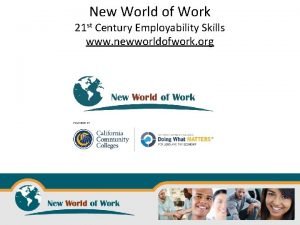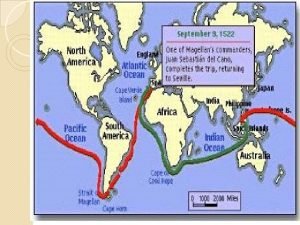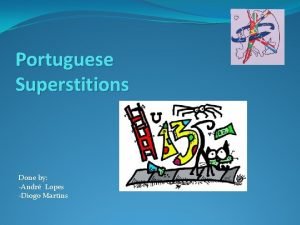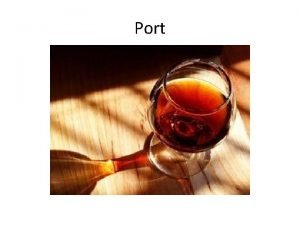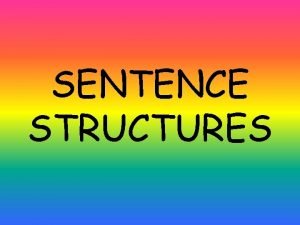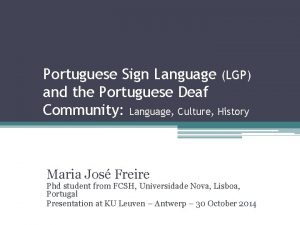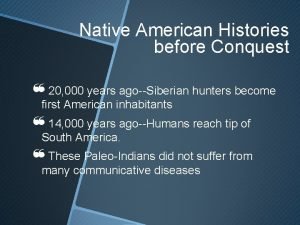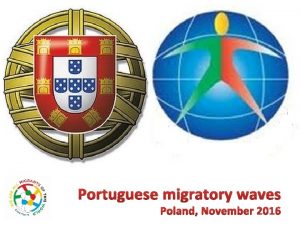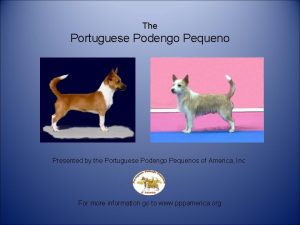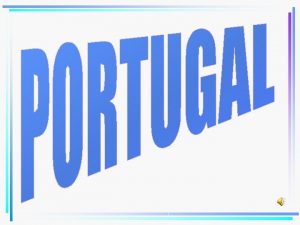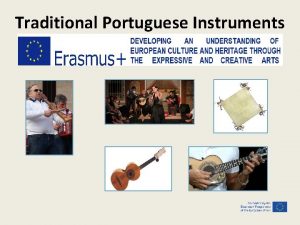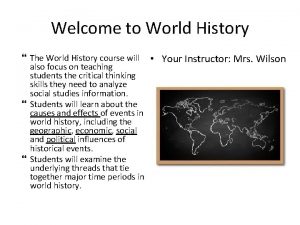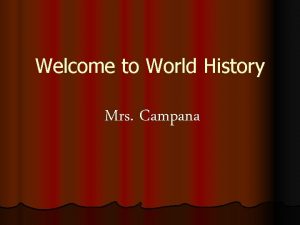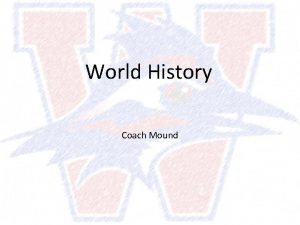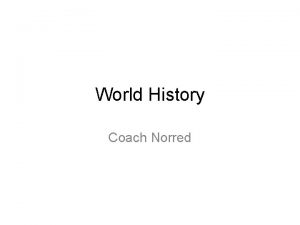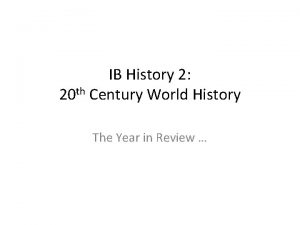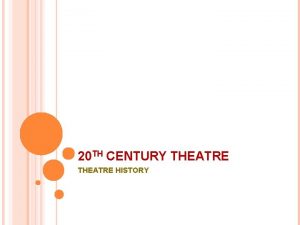Welcome to AP World History Century of Portuguese



















- Slides: 19

Welcome to AP World History


Century of Portuguese Exploration � Prince Henry the Navigator 1415 -1460 collected latest information about sailing and geography � No one knew how big Africa was, but he pushed for discovery � � Built sturdy ships and made it around Cape Verde to West Africa � Traded for gold, slaves, and ivory � Colonized Cape Verde Islands and developed sugar plantations using African slaves.

Century of Portuguese Exploration � 1480 begin looking for sea route to Asia � ‘ 88 Bartolomeu Dias first to sail around “Cape of Good Hope” � ‘ 98 Vasco da Gama commanded first ship to make it to India “To serve God and His Majesty, to give light to those who were in darkness and to grow rich as all men desire to do” Bartholomew Dias

Century of Portuguese Exploration � Result: � New sea route eliminated overland travel, intermediate merchants, and mark ups � Network of outposts were placed in Africa and Asia � Developments in sailing were employed by other Europeans

West Africans and Europeans Meet � Different view of land For Europe it was scarce, for Africa it was abundant � Result = Africa was focused on labor as opposed to territory. Kingdoms were created by people who controlled the most valuable labor, not land. � � 1500: mainly the Spanish and Portuguese, followed by the Dutch and English, traded goods such as guns for slaves � Result: Starts the Triangular Trade. Slave labor, although it had always existed, was expanded on a massive scale � Irony: Seen as a story of European migrations, but between 1650 -1831, more Africans than Europeans will come to the New World. � “In terms of immigration alone… America was an extension of Africa rather than Europe until the late 19 th century. ”

Remember, various factors encouraged exploration. But what specifically brought Columbus to the Americas? RANCID MEAT

Columbus • • • "Obsessive, religious, stubborn, arrogant, charming, egotistical" From Italy. Started sailing at 14. Knew earth was a sphere and wanted to sail West from Europe to Asia After trying with Portugal, France, and England, the Spanish King Ferdinand Queen Isabella said yes Flawed calculations Guessed 2, 500 miles and was 7, 500 miles short! Oct 12, 1492 after 5 weeks they landed in the Bahamas Just in time too! Thought he had made momentous discovery Died in 1506 never knowing he had reached unknown continent separating Asia from Europe!

That award actually goes to… Magellan • First to circumnavigate the globe

Spanish Conquest & Colonization

Spanish Conquest & Colonization � Conquistadores were sent to the Americas to conquer for GOD, GLORY, and GOLD � Looking for instant wealth, not permanent settlement � Used alliances, guns and horses to conquer territory and Native tribes. � Hernan Cortes = Invaded Cuba and Mexico; came back to Spain with huge amounts of gold. � � SIG = caused a mad gold rush to the New World “I and my companions suffer from a disease of the heart which can be cured only by gold. ” 1519: Conquered the 12? million Mexica (Aztecs) in present-day Mexico City and slaughtered over 50, 000 Francisco Pizarro = Invaded the Inca in Peru (1522). Conquered and took over 375, 000 sq. miles of land; over 7? million people. � � http: //www. youtube. com/watch? v=k. Ke. B 82 ret. Ls Eventually, they fought over the gold and he was killed.

Power � Spain sent royal governors to rule colonies. � Gold and silver from the Americas were shipped to Spain, making it the strongest power in Europe in the 16 th century. �The conquerors used the Native Americans to farm the land work the mines. Many Native Americans died from the harsh working conditions and smallpox disease. African people were brought over to do the work instead. E. Napp

What happened when these worlds met? � At first: Native’s held own in cultural negotiations. Accepted trading of goods but resisted other aspects of Euro culture. � Did not perceive themselves as disadvantaged. � � Then: Cooperation became less frequent. � Disease destroyed them. No germ theory yet. � Civilizations conquered, leaders overthrown, religion held in contempt, and forced to work for the Spanish � Survivors found traditional culture unraveled. � �A name to know:

Europe and the Spanish Example � 16 th century belonged to the success of the Spanish and Columbus � Initiated the Columbian Exchange that continues to this day � Spain’s example � Atlantic was no longer a barrier after millions of years � Lesson learned by the Europeans: New World could vastly enrich the old. European Kings begin to increase their wealth and power through conquest and colonization.

Toll of Spanish Colonization � Geographic Revolution � Columbian Exchange � Native Americans devastated � Africans enslaved � Europeans gain wealth and a new “culture” of colonization and royal power among nations is strengthened

English Settlement � Motive: � Unlike France or Spain, colonization did not come from desire for a centralized empire. Instead, crown offered charters to entrepreneurs, religious idealists, and aristocratic adventurers. � Result: � Establishment of separate and profoundly different colonies. Each developing regional identities that exist to this day. � Process was slow and uneven. � By the 17 th century, transformed into a new world that produced raw materials and purchased manufactured goods.

Breaking Away: Decisions to Move to America � Improve social position � Own land � Practice purer form of worship based on new interpretation of scripture � Get away from constant and violent religious controversy � Support colonizing efforts in spite, as a result of Anti. Catholicism and rivalry with Spain

Brief Comparison: An English Model of Colonization in North America � Different than Spain � Societies of settlers vs. society of Indians rules by tiny group of Spanish Did not serve as source of labor as did in New Spain � Thrived on agriculture vs. mining for silver and exploiting Indian labor � Slave labor could be found, but many depended on labor of family members � Protestantism prevailed, but diversity existed Both relaxed & straight-laced Continued to splinter Religious toleration valued � English laws, habits, ideas, and language dominated colonies � Free adult white men had an extraordinary degree of political influence � Note: Not a complete list of differences

Your goal… � You want to compare the Latin American colonies, the Sugar colonies, and the North American colonies � You also want to compare the American empire building process with the Russian. � Lastly, you want to compare the European empires to the Asian.
 New world of work badges
New world of work badges Ap world history chapter 25 africa and the atlantic world
Ap world history chapter 25 africa and the atlantic world Countries michael jackson visited
Countries michael jackson visited Welcome welcome this is our christmas story
Welcome welcome this is our christmas story Ako ay isang portuges
Ako ay isang portuges The florida keys are a beautiful chain
The florida keys are a beautiful chain Superstitions in portugal
Superstitions in portugal Portuguese christmas traditions
Portuguese christmas traditions Portuguese fortified wine
Portuguese fortified wine Portuguese dewy pine
Portuguese dewy pine What does baroque mean in portuguese
What does baroque mean in portuguese Define supersition
Define supersition Portuguese sentence structure
Portuguese sentence structure Asl sign portugal
Asl sign portugal Portuguese mano war
Portuguese mano war Portuguese christmas songs
Portuguese christmas songs Samantha warwar
Samantha warwar Portuguese sailor
Portuguese sailor San salvador
San salvador Christmas songs with figurative language
Christmas songs with figurative language
